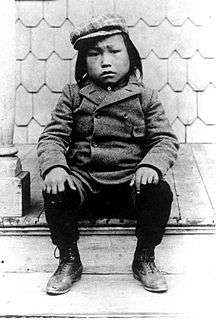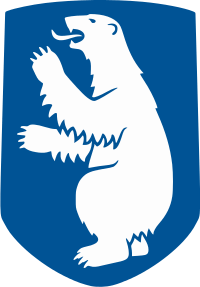Inughuit
|
Minik Wallace, Inuk, c. 1890–1918, in New York | |
| Total population | |
|---|---|
| 800 (2010)[1] | |
| Regions with significant populations | |
|
| |
| Languages | |
| Inuktun |
The Inughuit (also spelled Inuhuit), historically Arctic Highlanders, are Greenlandic Inuit. Formerly known as "Polar Eskimos", they are the northernmost group of Inuit, and the world's northernmost people, living in Greenland. Inughuit make up about 1% of the population of Greenland.[2]
Language
The Inughuit speak Inuktun, also known as North Greenlandic, Thule Inuit, or Polar Eskimo. It is a dialect of Inuktitut, an Eskimo–Aleut language related to the Greenlandic language spoken elsewhere in Greenland.[3] In Kalaallisut, the official dialect of Greenlandic, Inuktun is called Avanersuarmiutut.
Population
Before 1880, their population was estimated to be between 100 and 200 people. From 1880 to 1930, they were estimated to number 250. In 1980, their estimated population was 700,[2] and it rose to 800 in 2010.[1]
European contact
The Inughuit were first contacted by Europeans in 1818,[2] when John Ross led an expedition into their territory. Ross dubbed them "Arctic Highlanders". They are believed to have previously lived in total isolation, to the point of being unaware of other humans, and are cited as one of the only non-agricultural societies to live without armed feuds or warfare, a state that continued after contact.[4]
In 1908 and 1909, the Inughuit were instrumental in assisting both Frederick Cook and Robert Peary on their claimed conquests of the North Pole.
Erik Holtved, a Dane, was the first university-trained ethnologist to study the Inughuit.[5]
Settlements
Inughuit people live north of the Arctic Circle on the west coast of Greenland, between 75°—80° N and 58°–74° W. The northernmost settlement was at the village of Etah (at 78° 19' N), but it was abandoned due to the extremely harsh conditions there. The northernmost constant settlement is now Hiurapaluk.
Pituffik, also known as "Dundas" or "Thule" to Europeans, was the chief settlement of the Inughuit until 1953 when it was displaced by the United States' Thule Air Base, with its residents relocated to Qaanaaq. Established in 1953, Qaanaaq is the largest Inughuit settlement.[1]
See also
References
- 1 2 3 Leonard, Stephen Pax. "The disappearing world of the last of the Arctic hunters." The Guardian. 2 Oct 2010. Retrieved 25 Feb 2012.
- 1 2 3 "Inughuit: Orientation." Countries and Their Cultures. Retrieved 25 Feb 2012.
- ↑ "Inuktitut, Greenlandic." Ethnologue. Retrieved 25 Feb 2012.
- ↑ Keely, Lawrence (February 1996). War Before Civilization. Oxford University Press. p. 30. ISBN 9780199761531. Retrieved 28 April 2016.; (book article)
- ↑ Malaurie, Jean (2003). Ultima Thulé: Explorers and Natives of the Polar North. Norton. ISBN 978-0-393-05150-6., pages=323–5
External links
- The Inughuit tribe of Northern Greenland, BBC
- Recognizing the Inughuit as a Distinct Indigenous People of Greenland and their Right to Return to their Traditional Lands, Inuit Circumpolar Conference Executive Council Resolution 03-02

